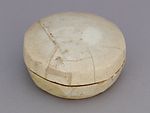Box
About this object
History of use
Chinese ceramics were important trade items in southeast Asia during the 11th-16th centuries and became fully integrated with ideology and ritual in Philippine societies, playing an important role in all aspects of cultural life (Langrick, p.61). Their functions were varied and included utilitarian, ceremonial and religious roles as heirlooms, and in mortuary ceremonies as burial goods and items of prestige. Chinese ceramics constitute the vast majority of burial goods excavated in the Philippines. Buried with the deceased, they acted as indicators of wealth, protected the departing spirit from evil and serving as provisions for the afterlife. Turned-over plates and bowls were used to cover certain parts of the body, establishing a protective area. In addition, many excavated ceramics were miniaturized replicas of larger, functional vessels--symbolic substitutes for provisions for the afterlife. In addition, small jarlets and bottles and other containers were used for ritual substances (oils, herbs, aromatic resins) and for food offerings necessary for the departing spirit. Most of the trade ceramics excavated in the Philippines show little or no evidence of usage before burial. According to Addis, white ceramics or Qing-bai wares were produced at the Jingdezhen kiln, Fuliang County in China and probably began in the Late Song dynasty (1127-1279), ending in the Yuan dynasty (1260-1368). Qing-bai ceramics were important export wares for the Southeast Asian market. From the condition of trade ceramics shown in published sources and the Tecson collection, it appears that most of the wares were kiln seconds, or rejects. They were nevertheless regarded with high esteem and actively traded.
Narrative
This box is part of a collection of Chinese ceramics found in burial context in the Philippines and was excavated at a burial site in the town of Lumban, Laguna Province, Philippines. Repairs were done by specialists employed by archaeologists and the Philippines National Museum. They were artists by training.
Cultural context
exchange; status; ceremonial; mortuary
Iconographic meaning
In many indigenous groups of the Philippines, supernatural power was attributed to Chinese ceramics because of the ringing sound emitted when lightly tapped and their vitreous, shiny glazed surfaces which impart an impermeable quality. The ringing sound was seen as a magical voice able to attract the attention of powerful ancestor spirits. Their impermeable and seemingly imperishable surfaces were believed to have great protective power against all kinds of influences, from evil spirits to poisons (Langrick, p. 55-56).
Physical description
Octagonal ceramic box with lid. Base and lid are of equal proportions with a slightly convex underside. Grey white body with fine glaze crackling. Outer edge of lid surface is ornamented with a faint combed wave pattern. The underside, 0.7 cm. of the base, lip, and most of the side of the box are unglazed. The box has an overglaze character in the inside surface. The lid is glazed throughout except for the rim and parts of the upper inner sides. Two sets of inked letter and numbers one on the inside lid and one on the underside.
Date Made
Song Dynasty (960-1279)
Date Acquired
16 Nov 1987
How Acquired
Donated
Credit Line
Measurements
5.8 x 11.4 cm
Object Number
Ia277 a-b
